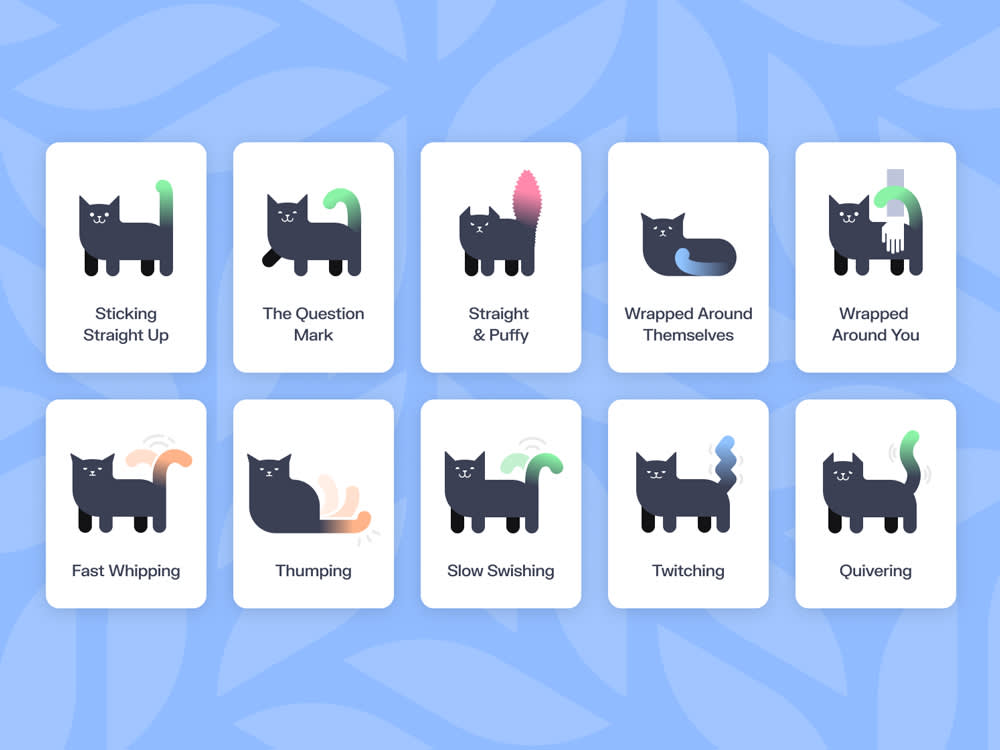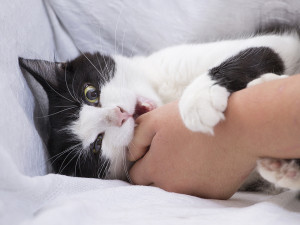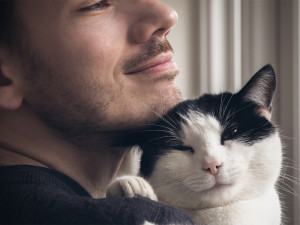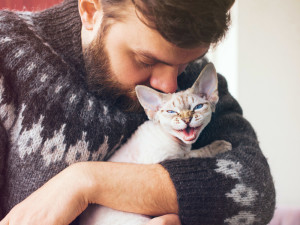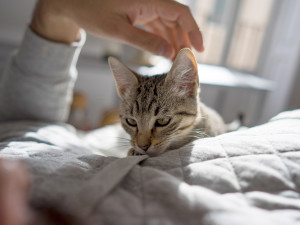Cat Tail Meanings
Cats are enigmas. But their tail movements can reveal a lot about their moods.
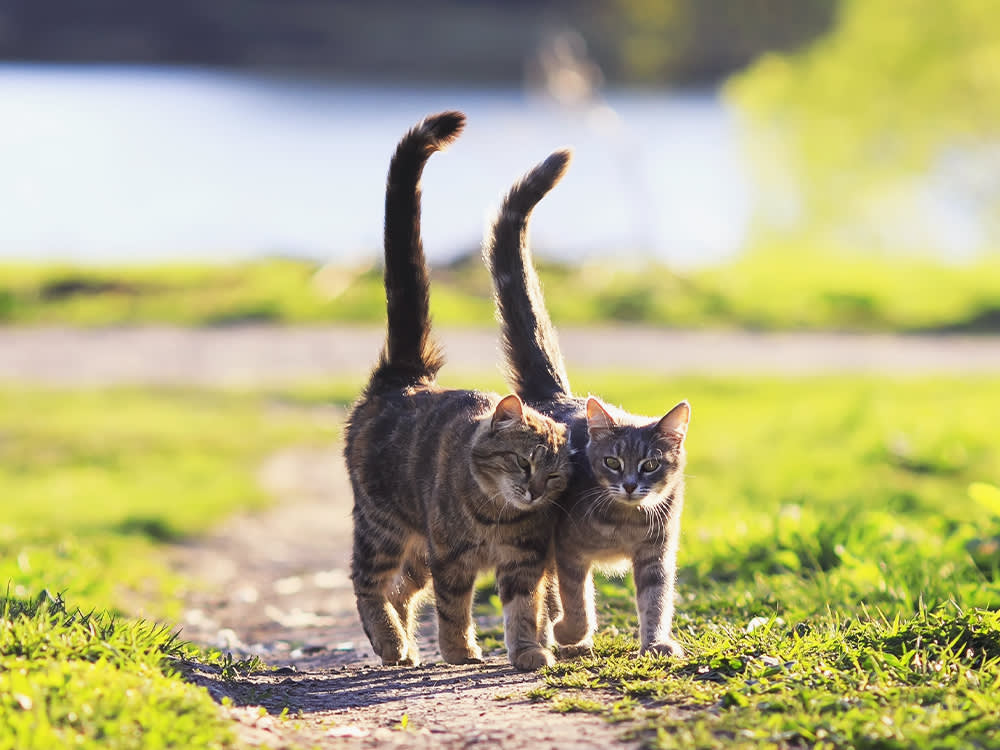
share article
Cat tail language is a real thing — because cats use their tails for all sorts of things — from balancing to marking their territory to knocking your favorite vase off the bookshelf. But more than anything, cats wag their tails to communicate, both with humans and with other cats. And while other forms of cat communicationopens in a new tab can be quite difficult to decipher — Why do you keep meowing at meopens in a new tab? I already fed you and cleaned your litter box! — “tail talk” is generally pretty straightforward and easy to understand, according to cat behaviorist and The Wildest Collective member and cat behaviorist Cristin Tamburoopens in a new tab.
“Cats are actually quite communicative creatures,” she says. “And their tails often tell most of the story.” Even a cat biting their tail could be trying to tell you something. Here, we interpret 10 cat tail movement meanings.
A cat’s tail can be a useful indicator of their mood. It’s important to consider the context in which your cat’s tail is moving when interpreting their mood. If you are unsure about what your cat’s tail is trying to tell you, it’s always best to consult with a veterinarian or animal behaviorist. They can help you to interpret your cat’s body language and recommend ways to improve your communication with them.
Cat tail positions and their meanings
1. Sticking straight up
As long as your cat’s tail isn’t puffed up, with all the hair sticking out like a pipe cleaner, this is a good thing. Your cat is telling you that they are happy and comfortable and just generally in a good mood. They are strutting their stuff and feeling their oats.
2. The question mark
This is another happy one and often indicates a desire to interact, per Tamburo. So, if you see your cat’s tail sticking out with a curl towards the end, take a moment to give them a stroke or a snuggle or a headbutt opens in a new tab— or a little play, ’cause they’re literally begging for it.
3. Straight and puffy
Sometimes paired with an arched back and a hiss, a tail that is puffed up and rigid indicates a cat in distress — one who has either been startled or is feeling in some way threatened. Look where they’re looking, and you’ll probably see what’s freaking them out. And if it’s a person, you best believe they did something to deserve it. Cats don’t lie.
4. Wrapped around themselves
Usually, when a cat lies down, their tail will relax away from their body, so when they wrap it close around themselves, it could be an indication that they are feeling ill or in some sort of pain. If you notice this behavior, give them their space, but keep an extra close eye on them.
Are they eating and drinking like normal? Pooping and peeing at least once a day? Hiding under furniture? Disinterested in play or treats? If this goes on for more than a day or so, call your vet.
5. Wrapped around you
This is sort of the cat equivalent of a hug and is often part of a happy greeting that may include rubbing up against you and contented purringopens in a new tab.
6. Fast Whipping
A cat tail whip is a sign of fear or aggression and a warning to stay away or stop doing whatever it is that you’re doing.
7. Thumping
Like fast whipping, this is an indication that your cat is angryopens in a new tab, or, at the very least, annoyed.
8. Slow Swishing
Not all motion is bad! A cat swishing their tailopens in a new tab from side to side is an indication that they intensely focused, sort of like the way humans sometimes tap their feet when they’re working. Often, you’ll see cats doing this while at play or watching a bird or squirrel through the window.
9. Twitching
Like slow swishing, small, jerky movements of the tail are common during play and hunting. But Tamburo says that a cat wagging their tail can also be a sign of mild irritation, so use your best judgment.
10. Quivering
Someone’s excited! Like a shiver running down your spine, a cat’s tail quivers when they are particularly well stimulated, like when they see their human after a long absence or when they see another cat.
They also tend to do it while spraying, so if you see your cat walking around your yard with their tail all aquiver, probably best to let them finish what they’re doing before running over for a snuggle.
Can I interpret a cat’s emotions solely based on tail position?
Cats’ tails tell a good portion of their emotional story — but their ears can be telling, too: A study published in the journal opens in a new tabfound that the ear positions of cats interacting with other cats are actually the best predictor of the outcome and whether it’s positive or negative.
And, of course, the sounds your cat makes are another indication of their feelings: Meowing can mean “hello” or be an objection. Purring, of course, is usually a sign of contentment. Growling or hissing often means a cat is scared or angry. And a yowl usually means a cat is in distress.
What are other ways to read my cat’s emotions?
If your cat doesn’t have a tail, perhaps because of an accident, don’t fret. “While it can be challenging for cats to adapt to the loss of their tails, they’re pretty resilient creatures and will generally figure it out,” Tamburo says. “For those cats, it’s important to watch their body posture, eyes, ears, and whiskers to learn what their tails might tell you otherwise. And, as with any cat, the more time you spend with them, the more familiar you will become with how and what they are trying to communicate.”
FAQs (People also ask):
Do kittens and older cats exhibit the same tail behaviors?
Some behaviors carry over from kittenhood to older cats — for example, kittens greet their mom with high tails and adult cats continue to do this with their favorite people.
References:

Charles Manning
Charles Manning is an actor, writer, and fashion/media consultant living in New York City with his two cats, Pumpkin and Bear. Follow him on Instagram @charlesemanningopens in a new tab.
Related articles
![cat snuggling man]() opens in a new tab
opens in a new tabWhat’s Your Cat’s Love Language?
Five surprising ways cats show affection (and how you can show it back), according to a cat behaviorist.
![cat meowing]() opens in a new tab
opens in a new tabWhy Does My Cat Meow So Much? Reasons Your Cat Meows Excessively
How to decode your cat’s love language when one meow has many meanings.
![cat hissing under chair]() opens in a new tab
opens in a new tabCat Hissing: Fair Warning or Fighting Words?
Your cat’s hissy fit could mean Don’t test me or Let’s do this. We wouldn’t call their bluff.
![cat staring at person on table]() opens in a new tab
opens in a new tabWhy Does My Cat Stare at Me?
...Is it something you said?
![kitten sleeping on top of person]() opens in a new tab
opens in a new tabWhy Does My Cat Sleep on Me?
Not into cuddling? Too bad — they’re spending the night.
![Cat kneading pet parent]() opens in a new tab
opens in a new tabWhy Does My Cat Knead Me?
Among other things, “making biscuits” is a sign of affection. We’re not crying…

